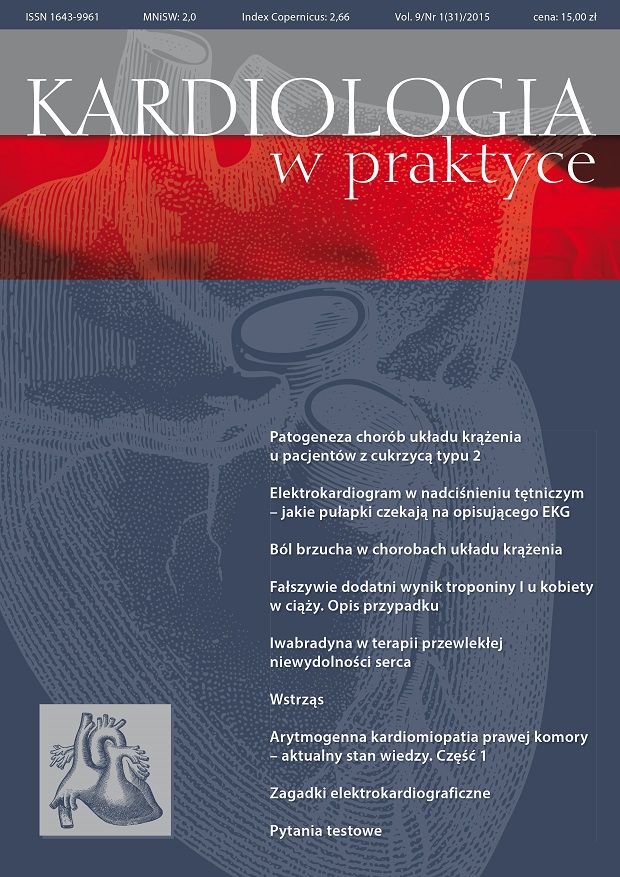Electrocardiogram in arterial hypertension – difficulties that are waiting for the doctors Case report
Main Article Content
Abstract
Arterial hypertension may induce left ventricular hypertrophy (LVH). Electrocardiographic signs of LVH are accepted as independent cardiovascular risk factor in hypertensive patients. In this paper, the most popular diagnostic criteria of LVH are presented, as well as possible reasons of false negative and false positive results. There are pointed features of ECG that made diagnosis of LVH more probable. ECG changes that can interfere with ECG interpretation in another pathologies are also discussed.
Downloads
Article Details

This work is licensed under a Creative Commons Attribution-NonCommercial 4.0 International License.
Copyright: © Medical Education sp. z o.o. This is an Open Access article distributed under the terms of the Attribution-NonCommercial 4.0 International (CC BY-NC 4.0). License (https://creativecommons.org/licenses/by-nc/4.0/), allowing third parties to copy and redistribute the material in any medium or format and to remix, transform, and build upon the material, provided the original work is properly cited and states its license.
Address reprint requests to: Medical Education, Marcin Kuźma (marcin.kuzma@mededu.pl)
References
2. Kannel W.B., Gordon T., Castelli W.P. et al.: Electrocardiographic left ventricular hypertrophy and risk of coronary heart disease. The Framingham study. Ann. Inter. Med. 1970; 72: 813-822.
3. Prineas R.J., Rautaharju P.M., Grandits G. et al.; MRFIT Research Group: Independent risk for cardiovascular disease predicted by modified continuous score electrocardiographic criteria for 6-year incidence and regression of left ventricular hypertrophy among clinically disease free men: 16-year follow-up for the Multiple Risk Factor Intervention Trial. J. Electrocardiol. 2001; 34: 91-101.
4. Levy D., Salomon M.D., Agostino R.B. et al.: Prognostic implications of baseline electrocardiographic features and their serial changes in subjects with left ventricular hypertrophy. Circulation 1987; 75: 565-593.
5. Hancock E.W., Deal B.J., Mirvis D.M. et al.: AHA/ACCF/HRS recommendations for standardization and interpretation of electrocardiogram part V: electrocardiogram changes associated with cardiac chamber hypertrophy: a scientific statement from the American Heart Association Electrocardiography and Arrhythmias Committee, Council on Clinical Cardiology; the American College of Cardiology Foundation; and the Heart Rhythm Society. Endorsed by the International Society for Computerized Electrocardiology. J. Am. Coll. Cardiol. 2009; 53: 992-1002.
6. Romhilt D.W., Estes E.H.: A point score system for the ECG diagnosis of left ventricular hypertrophy. Am. Heart J. 1968; 75: 752-758.
7. Baranowski R., Wojciechowski D., Maciejewska M. et al.: Zalecenia dotyczące stosowania rozpoznań elektrokardiograficznych. Dokument opracowany przez Grupę Roboczą powołaną przez Zarząd Sekcji Elektrokardiologii Nieinwazyjnej i Telemedycyny Polskiego Towarzystwa Kardiologicznego. Kardiologia Polska 2010; 68(supl. IV).
8. Maciejewska M., Dabrowska B.: Influence of serum potassium on the electrocardiographic pattern of left ventricular hypertrophy in primary hyperaldosteronism. Clin. Cardiol. 1992; 15: 725-727.
9. Bacharova L., Szathmary V., Kovalcik M. et al.: Effect of changes in left ventricular anatomy and conduction velocity on the QRS voltage and morphology in left ventricular hypertrophy: a model study. J. Electrocardiol. 2010; 43: 200-208.
10. Surawicz B., Knilans T.K.: Chou’s electrocardiography in clinical practice. 6th ed., Saunders Elsevier, Philadelphia 2008.
11. Schocken D.D.: Electrocardiographic left ventricular strain pattern: Everything old is new again. J. Electrocardiol. 2014; 47: 595-598.
12. Birnbaum Y., Alam M.: LVH and the diagnosis of STEMI – how should we apply the current guidelines? J. Electrocardiol. 2014; 47: 655-660.

